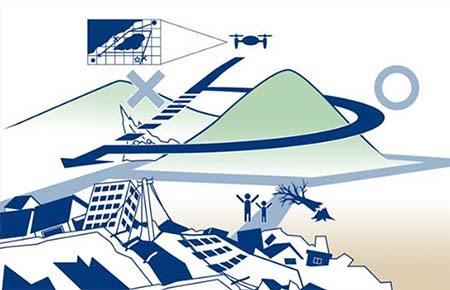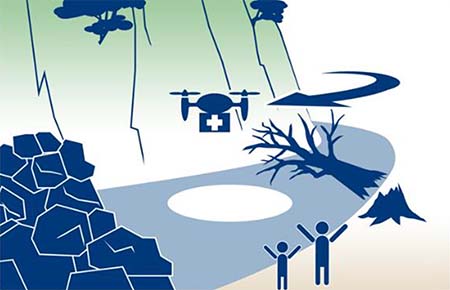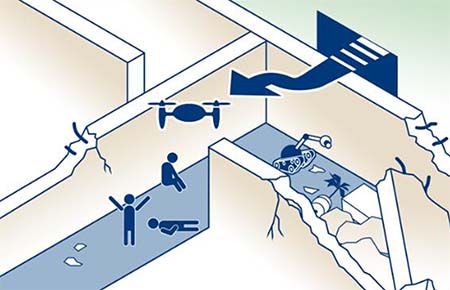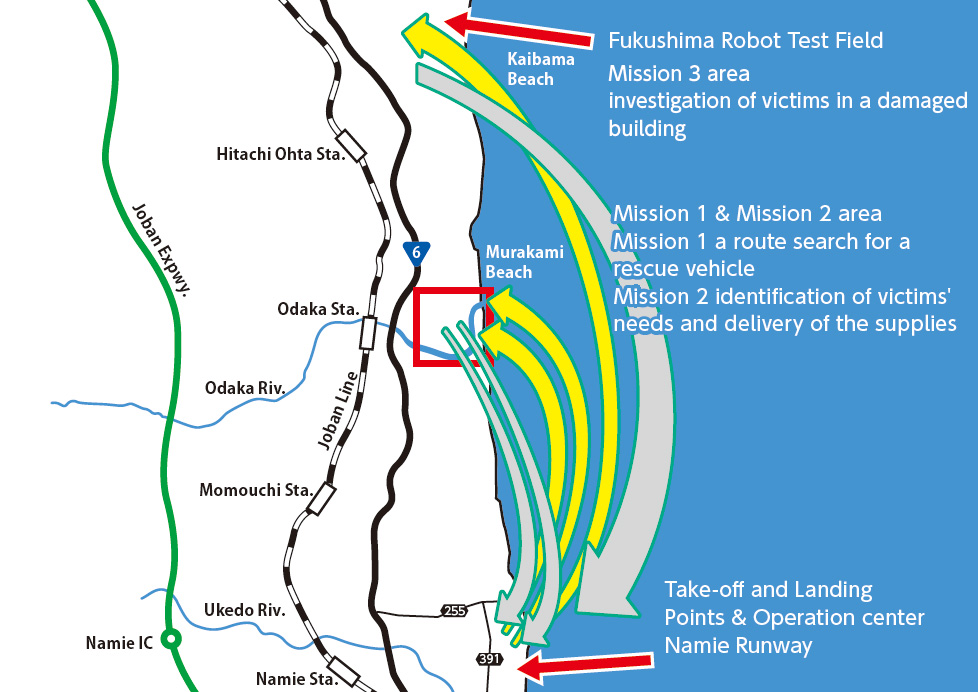![World Robot Summit 2025 Harsh Environment F-REI Challenge [Harsh Environment Drone Challenge (HEDC)]](images/hedc/page_ttl.png)
The mission of Harsh Environment Drone Challenge (HEDC) is
to rescue victims immediately with advanced robots in case of a large-scale disaster.
Under that circumstance, ground vehicles and ships were completely unusable.
Therefore, HEDC participants are supposed to execute three missions,
such as the survey of the damage or the supply delivery, using multiple UAVs.
Task

MISSION 1 Rescue vehicle route search using a flying robot
Aerial exploration of designated areas with a flying robot, identification of the location and type of obstacles, and establishment of a route for dispatching rescue teams
- Challenge
- The accuracy and speed of disaster occurrence situation investigation

MISSION 2 Identifying the location of people in need of rescue, understanding and transporting requested support supplies
Searching for multiple victims and reporting their exact locations and conditions.
And understanding the type of requested relief supplies by recognizing the letters painted on the ground, and delivering them to designated locations.
- Challenge
- The accuracy and speed of deciphering the relief supplies needed by the disaster victims, and transporting those supplies.

MISSION 3 Understanding the situation of disaster victims in remote buildings
Approaching with a flying robot to remote buildings and investigating the damage situation inside those buildings.
And understanding the numbers of survivors and their situations in creating a 3D map and reporting the location of them.
- Challenge
- The accuracy and speed of investigating the damage situation inside the building, searching for disaster victims, and providing their information.

Detailed Guidance
(For participants)
When participating in the HEDC, it is essential to prioritize safe UAV flight operations in your flight planning.
Compliance with Japanese domestic laws is mandatory,
and any team found in violation will be disqualified without exception.
Please ensure to watch the detailed guidance videos below and prepare accordingly for participation.
1. Mission Scenario and Evaluation Criteria
2. Safety Rules,Evaluation Method and Factors
3. Japanese Radio Regulations for UAV Operations
4. Flight Rule for Unmanned Aircraft and The Drone Act
Q & A
- Q.Is it permitted to change team members after submitting the Entry Form?
- A.You are permitted to change team members after submitting the entry form. It is because during the process of obtaining flight approval from the Japan Civil Aviation Bureau (JCAB), some adjustments might be needed following the instructions from the bureau. However, please note that after JCAB approval is granted, changes will not be permitted unless there are extraordinary circumstances.
Note: While registering more than 10 for getting flight approval from JCAB is permitted, the number of team members permitted for the competition is limited to 10.
- Q.Is it necessary to register Unmanned Aircraft (UA) with JCAB in advance?
- A.As specified in the application guidelines, it is preferable to register UA with JCAB in advance and obtain an aircraft registration number.
- Q.We plan to secure radio wave communication through our own strategy, but intend to install LTE communication equipment onboard as a backup communication method for safety purposes. If we clearly indicate to judges at all times which communication channel is being used, will we avoid penalty?
- A.Clearly indicating the radio wave communication channel can avoid penalty. Just installing LTE equipment will not result in any penalty.
- Q.Is there any plan to unveil the detailed evaluation criteria and scoring information?
- A.As stated in the application guidelines, the HEDC Competition Committee emphasizes proposals of new technologies and solutions aimed at achieving mission scenarios; therefore, there are no plans to release detailed evaluation documents.
Note: Specific evaluation criteria and scoring distribution have been predetermined by the Evaluation Committee, and assessments will follow these criteria.
- Q.Is it correct that strategies to complete the missions are up to teams, and evaluations will be based on the strategies and achivement?
- A.Evaluations will comprehensively consider both the strategies and actual performance. Scores will be decided through deliberation among multiple judge committee members.
Note: The HEDC Judge Committee is organized independently from the HEDC steering Committee. On the day of the competition, judge committee members will individually conduct evaluations.
- Q.Regarding the safety measures confirmation on Sheet 2 of the participation application form, there requires an 'image showing the installation of an emergency location reporting system (e.g., Trackimo, SPOT, etc.)'. Our team is using a Ublox M9N GPS module connected to a Pixhawk flight controller to receive GNSS signals. Does this requirement mean that a standalone GPS module such as Trackimo or SPOT, separate from the aforementioned system, is required?
- A.A standalone reporting system is required.
- Q.In Mission 3, is it permitted that the main UAV circling in fixed-wing mode above the urban area during the small multicopter (small UAVs) conducting exploration within the urban field?
- A.Unless it does not fly outside the designated flight area, it is permitted.
- Q.With reference to the above question, would the circling flight over the land area between the RTF urban field and the coastline be permitted?
- A.Circling flight would be permitted within the designated flight area. However, around the area above high-voltage power lines, flight is permitted only above the tower, and prohibited above the wires.
- Q.With reference to the earlier question, are there any designated areas for conducting VTOL transition flights (between fixed-wings and multicopter mode)?
- A.There is no restrictions for conducting VTOL transition flights, as long as the flight altitude would be 150 meters or under, which is limited by the flight acts above event sites.
- Q.What should be done if it is technically impossible to install additional parachutes because of the limitation of payload specification of UAV?
- A.It is recommended to install parachutes for dispersing impact during a fall, however it is not mandatory.
Note: Safety is heavily emphasized. Therefore, teams must take safety measures based on the conditions of aircraft weight and flight speed.
- Q.As to the small multicopter (small UAVs) conducting exploration within the urban field, would it be subject to a point reduction if switching from Namie Runway control to proportional radio control for landing, after completing exploration of the urban field under control from the Namie Runway?
- A.It is desirable that all aircraft return to the Namie Runway. Therefore, if any aircraft does not return to the Namie Runway, there is a possibility of point reduction regardless of whether it is operated via manual control or not. Furthermore, even if the aircraft returns, there is also a possibility of point reduction if there was any manual control intervention during the flight.
- Q.Regarding the question above, I would like to ask an additional clarification.
In your response, you mentioned that "if there are aircraft that do not return to the Namie runway, there is a possibility of point deduction regardless of whether they are under transmitter control or not."However, upon reviewing the rulebook again, I understood that in Mission 3, small UAVs conducting building-interior inspections are not required to return to the Namie runway.
Could you please confirm this point once again? - A.As you correctly pointed out, small UAVs are not required to return to the Namie runway. We apologize for the oversight. However, please note that if there is manual transmitter control intervention during the flight, there is a possibility of point deduction. Therefore, even after completing the mission, if there is manual control intervention during the landing operation, points may be deducted.
- Q.Our UAV is designed with sufficient buoyancy to remain afloat even if it falls onto the water surface. In this case, would it still be necessary to equip additional buoys (floating system)?
- A.If the UAV can float on the water by itself, you do not need to equip with additional floats.
Note: If it can remain afloat on the warter, any mechanism can be acceptable. Please write down the mechanism in the proposal form.
- Q.What should be done if it is technically impossible to install floating system because of the limitation of payload specification of UAV?
- A.The requirement to install floating system applies specifically to aircraft that clearly risk submersion. Aircraft that already incorporate inherent submersion countermeasures are exempt from this requirement.
- Q.I have a question regarding the submission of aerial photography data for Mission 1.
Is there a designated data submission medium?
We are currently assuming microSD. - A.We are planning to prepare a cloud storage service, and have you to upload the data there. Further details will be provided later.
- Q.Do you have any specifications for the data submission format of the aerial photography for Mission 1?
- A.We are planning to have you to compile all of your data, including on-site photographs and a digital map with the route, into a single file, and upload to the above-mentioned storage.
- Q.In the Pre-Challenge held in 2024, the time limit was set to two hours. Will it be reduced to one hour for this Competition in 2025?
- A.The time limit will be set to one hour.
Note: This is to enable larger number of teams to participate in this Competition.
- Q.In executing Mission 3, is it permitted to detach small UAVs from a fixed-wing UAV flying through, instead of hovering, above the urban field. In that case, the detach point might be apart from recommended point (center of intersection). Is that permitted?
- A.It is permitted to detach the small UAVs from a fixed-wing UAV at the point apart from recommended point. However, points will be deducted when detaching apart form the recommended point.
